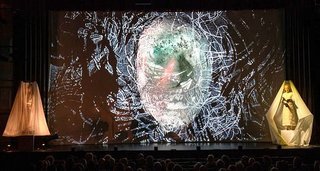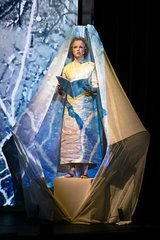|
Back
Dreams, Nightmares and Spectacles New York
Theresa L. Kaufmann Auditorium, 92nd Street Y
03/07/2020 -
“Mythos”
Toshio Hosokawa: Futari Shizuka (US Premiere)
George Benjamin: Into the Little Hill
Kerstin Avemo, Charlotte Mundy (Sopranos), Ryoko Aoki (Noh actress), Lucy Dhegrae (Mezzo -Soprano)
Talea Ensemble, James Baker (Conductor)
Alexander Polzin (Artistic concept and design), Sommer Ulrickson (Choreography), Kate Bashore (Lighting design), Claudia Rohrmoser (Video design)

From Futari Shizuka (© Richard Termine)
“Myths must be kept alive. Those who keep it alive are the artists.”
“The cave you fear to enter holds the treasure you seek.”
Joseph Campbell (1904-1987)
To some of us, people exist and survive with their own myths. Religion and faith, politicians and lies, prayer (rather than physicians) inducing healing. To those who catalogued and exhumed and extolled myths of the world–Joseph Campbell and his rare brethren–myths are explanations and sometimes exhortations.
And to the artist and concept designer Alexander Polzin, the two myths which he and the Talea Ensemble brought to the 92nd St. Y last Saturday, became art. The art of hyperbole and mystery, arcane secrets and giant icons. “Mythos”, the title which encompassed the evening, brought together two myths from opposing sides of the world: the prototype Japanese myth of the ghost inhabiting a human figure; and the Teutonic Medieval metaphor of the Black Plague, namely the Pied Piper.
What did these two myths–namely two operas, by Toshio Hosokawa and George Benjamin–say to a modern audience? A full-house audience braving an invisible (though hardly mythical) virus to watch it. Ah, that had no answer.
If myth has an answer, it becomes science and history. The myths last night had to be examined for themselves. No answers, no explanations, but spectacles for their own sake.
The spectacle of Futari Shizuka was part Noh play (libretto by Oriza Hirata), part modern technical wonder. Two women on either side of the stage sung and chanted and told their story. Basically, a shipwrecked lady who confronts a ghost from hundreds of years ago, each recounting their histories. (The Program Notes declared that both operas reflected on our own times, but I tried to avoid that.)

K. Avemo (© Richard Termine)
The two narrators were Ryoko Aoki, shrouded on an extreme corner of the stage, hardly visible from my seat; and Kerstin Avemo, that extraordinary soprano who seemed to sing her role mainly above high C. The sounds were wonderful, the words were frequently blurred. But that was almost irrelevant.
Because the real “star” was the huge screen behind both actors, with concepts and designs by Mr. Polzin. They dwarfed everything else. Their images were as ghostly as a giant head or as vernal as branches coming from a tree. The start, with shadows of the Talea Ensemble behind the curtain, was already a pointer to the great shadow plays of Indonesia and Cambodia. (I am not that familiar with Japanese theater.) The coloring was colorless or shimming, the movements were elemental or surprising.
Whatever the story–a story which could be a Japanese anime–these were images out of Mr. Polzin’s depth of consciousness. Whether logical or rational or dealing with the tale told by the actors was not important. Mr. Polzin had brought the eerie, fragmented, highly coloured playing of the Talea Ensemble into a cosmos of its own, fragmented or whole, pulsing out with light, or hidden in the “treasured cave” of Joseph Campbell’s quote above.
Not (in E.E. Cummings’ words) “a universe next door”, but a Stephen Hawking universe beyond universes somehow drawn to seduce our own unspoken, undescribable visions.
After this, I felt, George Benjamin’s 35-minute opera, Into the Little Hill, would be equally dazzling. For one reason (listed below) it wasn’t.
Mr. Benjamin’s opera, Written on Skin, some years ago was one of the great highlights of New York musical theater. Yes, he is idiomatically master of orchestra (the musical equivalents of Caravaggio Chagall!) and drama. But equally because his librettists are masters of the inner story minimally told, and above all, of clarity. “I wanted (my opera)”, said Mr. Benjamin, “to be clear at any given moment so people could be open to the story while listening to the music.”
By using the myth of the Ratcatcher of Hamelin, a work so antithetical to that most primary instinct of protecting one’s children, Mr. Benjamin took on more than myth. He took on fear and trembling.
Again, we had a soprano and a contralto singing from either side of the stage, relating the story with shock (“Kill them, they bite, they steal”) to the pathetic (“Why must rats die, Mummy?”) to the inaudible. In fact, the voices here were cold, detached, stolid, they were the narrator of a ghoulish event, spoken eight centuries onward in a century filled with its own ghoulish events.
But are they rats? The images here are like the train stations going to Auschwitz. They wear clothes, they carry suitcases...
Behind them was the Talea Ensemble, in this case (as Mr. Benjamin said), “Lighting up the voices rather than overpowering them.” The composer’s sounds coming from the ever inventive Talea Ensemble, lit up the narrative with (what I could figger out) a banjo, a Hungarian cimbalom, basset horns, a bass flute, as well as the entire ensemble, all behind that gauzy scrim curtain.

Opening of Into the Little Hill (© Richard Termine)
The third elements were dancers, originally wandering through the audience, then portraying the story with modern dance movements, ending in executions of them all.
I wanted so much to like them. Yet next to Mr. Polzin’s colossal traumatic images in the Toshio Hosokawa opera, they seemed...well, like clever dancers illustrating a clever opera.
Mr. Benjamin needed more than that.
This shortcoming was entirely my own. Though, the imaginations of Mr. Benjamin and his librettist Martin Crimp are so vast that a few dancers inevitably minimize a great concept.
Saturday’s “Mythos” was still an important step for the 92nd St. Y, which is accustomed to soloists, chamber orchestras, speakers and debates. With these two works of lyrical theater, they have opened up a world of possibilities. Probably most will be earthly (though not necessarily mundane). These two came near to a Strindbergian Dream Play. Not the dreams of “I have a dream”. But those opposite auguries, these of the Danish Prince: “That sleep of death, what dreams may come.”
Harry Rolnick
|